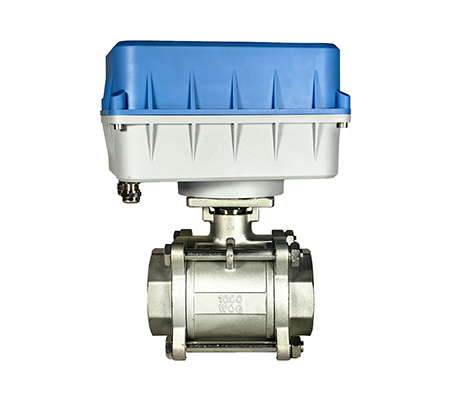Avoid your inquiry is delay response, please enter your WhatsApp/WeChat/Skype along with the message, so we can contact you at the very first time
We will reply you within 24 hours. If for urgent case, please add WhatsApp: +86 13188899036, or WeChat: 0531-87968777. Or call 0531-87968777 directly.
* We respect your confidentiality and all information are protected. We will only use your information to respond to your inquiry and will never send unsolicited emails or promotional messages.
I used to deal with rusty, unreliable valves that couldn’t hold up in demanding environments.
A stainless steel ball valve offers durable, corrosion-resistant flow control, especially when automated with an electric actuator for accurate, remote performance.

Once I started using stainless steel electric ball valves, system failures dropped and long-term performance improved. Here’s how these valves work and why they’re trusted in so many industries.
I once struggled to maintain reliable flow in a corrosive pipeline—until I switched to stainless steel valves.
Stainless steel balls are the internal core of ball valves, offering a smooth, corrosion-resistant surface for sealing and fluid control, especially in electric valve systems1.
Inside every ball valve is a spherical ball with a central bore. This ball rotates 90° to allow or block flow. When made from stainless steel, the ball resists corrosion, abrasion, and high pressure better than softer materials. This is especially critical in electric valve setups, where precise movement and long-term consistency are key.
| Feature | Stainless Steel Ball Valve Benefit |
|---|---|
| Surface Hardness | Reduced wear on seals and longer valve life |
| Corrosion Resistance | Performs well in wet, acidic, or salty systems |
| Strength | Withstands pressure surges |
| Cleanability | Suitable for food-grade and sanitary uses |
I’ve installed stainless steel electric ball valves in high-humidity mechanical rooms and process systems with zero corrosion after years of use. It’s a small change that delivers a huge leap in reliability.
Replacing valves too often used to cost me time, money, and customer trust.
A stainless steel ball valve with electric actuation can last 10–15 years or more with proper sizing, regular inspection, and stable operating conditions.
Ball valve lifespan depends on material quality, fluid type, frequency of operation, and maintenance. Stainless steel extends that life by resisting corrosion and wear. When paired with a high-quality electric actuator2, the setup delivers consistent operation over thousands of cycles.
| Factor | Impact on Lifespan |
|---|---|
| High-frequency cycling | May shorten seat life |
| Corrosive fluids | Increases wear unless stainless steel is used |
| Debris in fluid | May scratch or jam the valve |
| System pressure spikes | Can damage seals without control |
In one plant, I tracked stainless steel electric valves in high-temp glycol lines. After 12 years, the valves still sealed tightly, while neighboring brass units failed years earlier. Good materials and preventive checks go a long way.
In the past, I used gate valves3 for everything—until they jammed, leaked, and slowed my system response time.
Ball valves offer quick shut-off, better sealing, and easier automation than gate valves, making them ideal for modern electric valve systems.
Unlike gate valves that move a wedge vertically, ball valves turn 90° to open or close. That makes them ideal for electric actuators. Less movement means faster action and lower torque requirements. Gate valves take more turns to operate, are harder to automate, and often leak after prolonged use.
| Comparison Criteria | Ball Valve | Gate Valve |
|---|---|---|
| Operation | Quarter-turn | Multi-turn |
| Sealing performance | High (bubble-tight) | Moderate, worsens over time |
| Automation readiness | Excellent with electric actuators | Poor, needs heavy-duty actuator |
| Maintenance | Simple seat replacement | Full-body access needed |
I once replaced 12 manual gate valves in a chemical line with stainless steel electric ball valves. The flow became more stable, leaks disappeared, and operators could manage everything from a digital panel. The benefits were instant.
I used to settle for brass or iron valves—until corrosion4 shut down a jobsite.
Stainless steel valves resist corrosion, perform under pressure, and support automation, making them ideal for harsh or high-value applications.
When dealing with corrosive, hot, or variable fluids, I now go straight to stainless steel—especially when automation is involved. Electric actuators demand a stable mechanical base, and stainless steel valves provide that strength and reliability.
| Use Case | Stainless Steel Benefit |
|---|---|
| HVAC chilled water | No rust in high-humidity environments |
| Steam or hot oil systems | Maintains shape under thermal expansion |
| Saltwater/brine handling | Resists corrosion and metal fatigue |
| Industrial automation | Supports precise, consistent valve response |
I once worked on a coastal site where even coated iron valves rusted within 2 years. The stainless steel ball valves, however, remained spotless—and thanks to their electric actuators, we could shut off flow remotely during storms. That kind of dependability is why I always choose stainless steel for critical systems.
Stainless steel electric ball valves combine durability, tight sealing, and automation compatibility—making them the best choice for long-lasting, high-performance flow control.
Discover the advantages of electric valve systems, including precision control and energy efficiency, crucial for modern industrial processes. ↩
Learn how electric actuators enhance the performance and longevity of ball valves, optimizing your operational efficiency. ↩
Learn about the limitations of gate valves, including their maintenance issues and performance drawbacks, to make informed decisions for your projects. ↩
Learn about the impact of corrosion on valve performance and why stainless steel is a better choice for longevity. ↩